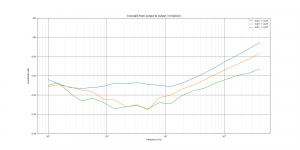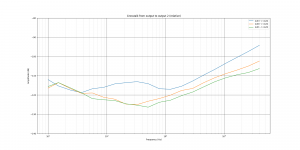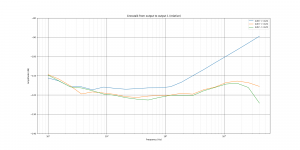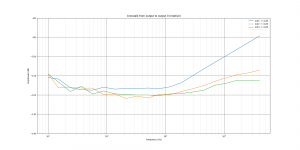I bought this USB3 soundcard to make measurements on various things, so... it's review time.
Unboxing
It looks nice and heavy, all metal case, quite flattering and robust. If you drop it, make sure it lands on the back, as they designed in a nice flange to protect the connectors. There is the same flange on the front, but it is too short to protect the knobs.
It is easy to open, just 4 screws.
Software installation and overall user experience
As tradition requires, the firmware updater crashed mid-update, bricking the device. Fortunately, the embedded guys at Steinberg are smart, so the embedded bootloader was still running and eager to load working code into its flash.
However, the PC software was written by idiots. The updater proudly displayed that the device had the latest firmware installed, and did not need to be updated. Noticeably, it lacked an "UPDATE IT ANYWAY FFS" button. Who needs to verify the checksum to make sure it is properly flashed? Just check the version byte and tada! done.
Customer support does not exist.
So I loaded the firmware upgrade app in the debugger, stepped through the asm code, found the place where it got the version number from the device, decremented the last digit in the memory dump, and hit "RUN". The idiot software was very happy to inform me that the device had the firmware version number I had just typed, and that it would update it.
It was a bit more complicated than this, but I'll spare you the details. I don't know why a firmware updater needs 15 threads and 2 state machines in 2 different threads to process sending and receiving USB messages, though. Mystery.
This time, it worked, and it unbricked itself.
The ASIO drivers are solid, no crash or bluescreen, which is worthy of notice.
Yamaha is very proud of their reverb (it does sound nice), and the PC software is written by idiots, so you have to look into google to find out how to disable the reverb, then find out for yourself. It has to be disabled in both mix busses, and the DAW has to be set to "solo", otherwise the inputs feed through into the outputs, which is what it's supposed to do if you're recording live and want to hear yourself playing.
Anyway.
USB port
It has a USB 3.1 type C port so it can power itself from a PC with a USB-C port. It also has a wall wart if you don't have a USB-C port. That's nice. It doesn't use the USB3 throughput, so it works fine on USB2, with the wall wart.
It doesn't work on Linux.
4 line outputs on 6.35 jacks
They are balanced, in the sense that they output a positive and negative signal:
Full scale digital output, 6.32 Vpp on the tip, 8.64 Vpp on the sleeve, so you get a bit extra signal for free.
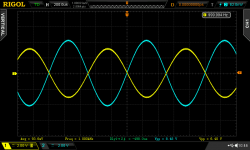
When either the tip or the sleeve is shorted, it does not distort, as some balanced drivers sometimes do. Instead it doubles the output on the other polarity, which is nice, and of course it clips hard.
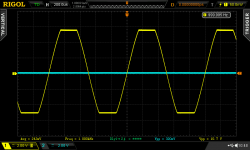
So you have to halve the level in software, for example to 0.45 full scale instead of 1. There is no analog gain control. Anyway, the outputs work.
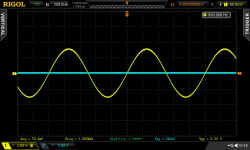
2 "main outputs" line outputs on 6.35 jacks, with volume pot, same signal goes to 2 headphone jacks, each with volume control.
These output the mix bus, so the PC can't use them as outputs. Even though it can, because it does, and the interface declares itself as 6 channel, but if you try to output a signal on them, it doesn't work. 4 outputs are fine, I don't need 6, so this is a problem for another day.
Unboxing
It looks nice and heavy, all metal case, quite flattering and robust. If you drop it, make sure it lands on the back, as they designed in a nice flange to protect the connectors. There is the same flange on the front, but it is too short to protect the knobs.
It is easy to open, just 4 screws.
Software installation and overall user experience
As tradition requires, the firmware updater crashed mid-update, bricking the device. Fortunately, the embedded guys at Steinberg are smart, so the embedded bootloader was still running and eager to load working code into its flash.
However, the PC software was written by idiots. The updater proudly displayed that the device had the latest firmware installed, and did not need to be updated. Noticeably, it lacked an "UPDATE IT ANYWAY FFS" button. Who needs to verify the checksum to make sure it is properly flashed? Just check the version byte and tada! done.
Customer support does not exist.
So I loaded the firmware upgrade app in the debugger, stepped through the asm code, found the place where it got the version number from the device, decremented the last digit in the memory dump, and hit "RUN". The idiot software was very happy to inform me that the device had the firmware version number I had just typed, and that it would update it.
It was a bit more complicated than this, but I'll spare you the details. I don't know why a firmware updater needs 15 threads and 2 state machines in 2 different threads to process sending and receiving USB messages, though. Mystery.
This time, it worked, and it unbricked itself.
The ASIO drivers are solid, no crash or bluescreen, which is worthy of notice.
Yamaha is very proud of their reverb (it does sound nice), and the PC software is written by idiots, so you have to look into google to find out how to disable the reverb, then find out for yourself. It has to be disabled in both mix busses, and the DAW has to be set to "solo", otherwise the inputs feed through into the outputs, which is what it's supposed to do if you're recording live and want to hear yourself playing.
Anyway.
USB port
It has a USB 3.1 type C port so it can power itself from a PC with a USB-C port. It also has a wall wart if you don't have a USB-C port. That's nice. It doesn't use the USB3 throughput, so it works fine on USB2, with the wall wart.
It doesn't work on Linux.
4 line outputs on 6.35 jacks
They are balanced, in the sense that they output a positive and negative signal:
Full scale digital output, 6.32 Vpp on the tip, 8.64 Vpp on the sleeve, so you get a bit extra signal for free.

When either the tip or the sleeve is shorted, it does not distort, as some balanced drivers sometimes do. Instead it doubles the output on the other polarity, which is nice, and of course it clips hard.

So you have to halve the level in software, for example to 0.45 full scale instead of 1. There is no analog gain control. Anyway, the outputs work.

2 "main outputs" line outputs on 6.35 jacks, with volume pot, same signal goes to 2 headphone jacks, each with volume control.
These output the mix bus, so the PC can't use them as outputs. Even though it can, because it does, and the interface declares itself as 6 channel, but if you try to output a signal on them, it doesn't work. 4 outputs are fine, I don't need 6, so this is a problem for another day.
Headphone amp
It makes my Sennheiser HD6XX sound like they're worth $10, so, not optimum.
Output to output crosstalk
To measure the output impedance and PSRR of a LDO we need to inject a signal in the input, then in the output. My old E-MU 0202 was always so generous to include a sizeable chunk of one channel into the other output channel, which had to be calibrated out, but this Steinberg is much better behaved.
Note the graphs show hardware channel numbers, for the back panel output jacks:
out0 is 1L
out1 is 1R
out2 is 2L
out3 is 2R
There is more crosstalk between L and R than between channels 1 and 2, so if you want 2 outputs with minimum crosstalk, you should use 1L and 2R, for example. Also the top channels (geographically speaking) are on a daughterboard, so there is a bit more crosstalk between 1L and 2L than 1L and 2R, or 1R and 2L.
Anyway, the absence of volume control is pretty nice, that's one less thing to calibrate out, since the relationship between output volts and sample value is fixed.
It makes my Sennheiser HD6XX sound like they're worth $10, so, not optimum.
Output to output crosstalk
To measure the output impedance and PSRR of a LDO we need to inject a signal in the input, then in the output. My old E-MU 0202 was always so generous to include a sizeable chunk of one channel into the other output channel, which had to be calibrated out, but this Steinberg is much better behaved.
Note the graphs show hardware channel numbers, for the back panel output jacks:
out0 is 1L
out1 is 1R
out2 is 2L
out3 is 2R
There is more crosstalk between L and R than between channels 1 and 2, so if you want 2 outputs with minimum crosstalk, you should use 1L and 2R, for example. Also the top channels (geographically speaking) are on a daughterboard, so there is a bit more crosstalk between 1L and 2L than 1L and 2R, or 1R and 2L.
Anyway, the absence of volume control is pretty nice, that's one less thing to calibrate out, since the relationship between output volts and sample value is fixed.
Attachments
Thanks for the review. Will you be publishing Analog I/O performance at some point?
That balanced output is worth a chuckle and a blush. Someone didn't do their job properly.
Any specific reason you picked the UR44 over the ID14 (for example)?
Edit: Ignore the first line, I see you're on it.
That balanced output is worth a chuckle and a blush. Someone didn't do their job properly.
Any specific reason you picked the UR44 over the ID14 (for example)?
Edit: Ignore the first line, I see you're on it.
Inputs
There are two balanced Jack line inputs at the back. They have a binary level control, pro level or consumer level, switchable from a checkbox stashed in the preferences dialog of the software. Pro has less noise, consumer has more gain.
There are four XLR/Jack combos on the front, with gain knobs.
If you plug a XLR, you get a balanced mic preamp with adjustable gain. The lowest gain setting will not accept a pro line level without clipping though.
If you plug in a jack in the two left inputs (appropriately labeled 1 and 2, so that's in0 and in1) you get an unbalanced "Hi-Z" mode that doesn't work at all, the signal is horribly clipped no matter the level.
If you plug in a jack in the two right inputs you get balanced line in, that will take pro line level. The gain knob also works on this line input.
The clipping LEDs are a bit paranoid and light up a few dB before clipping, so if they stay dark you can be sure it won't clip.
Loopback frequency response
See graphs. Note hardware channel numbers are 0-based.
Rear line inputs and XLR mic inputs have the best extension, -0.5dB at 40kHz when using 192ksps.
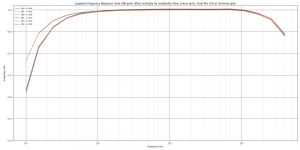
Front line inputs are -1dB down at 40kHz.
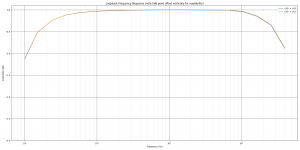
So, very usable, no problem here.
There are two balanced Jack line inputs at the back. They have a binary level control, pro level or consumer level, switchable from a checkbox stashed in the preferences dialog of the software. Pro has less noise, consumer has more gain.
There are four XLR/Jack combos on the front, with gain knobs.
If you plug a XLR, you get a balanced mic preamp with adjustable gain. The lowest gain setting will not accept a pro line level without clipping though.
If you plug in a jack in the two left inputs (appropriately labeled 1 and 2, so that's in0 and in1) you get an unbalanced "Hi-Z" mode that doesn't work at all, the signal is horribly clipped no matter the level.
If you plug in a jack in the two right inputs you get balanced line in, that will take pro line level. The gain knob also works on this line input.
The clipping LEDs are a bit paranoid and light up a few dB before clipping, so if they stay dark you can be sure it won't clip.
Loopback frequency response
See graphs. Note hardware channel numbers are 0-based.
Rear line inputs and XLR mic inputs have the best extension, -0.5dB at 40kHz when using 192ksps.

Front line inputs are -1dB down at 40kHz.

So, very usable, no problem here.
Any specific reason you picked the UR44 over the ID14 (for example)?
I need 192k and 6 analog inputs to measure base current, emitter current, and Vbe of an output stage pair simultaneously, for a... project.
Input crosstalk
In order to measure things, like LDOs or filters, this also has to be accounted for, since you want to measure both the input (for calibration) and output (for measurement) of the device under test, too much crosstalk in the soundcard screws things up.
The rear line inputs have little crosstalk with anything, especially the front inputs.
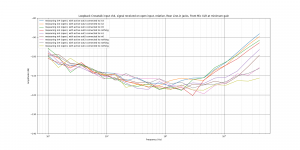
The two front line inputs have quite a bit of crosstalk between each other, but not with the back line inputs.
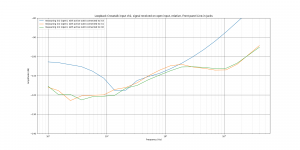
The four front XLR inputs have an embarrasingly high amount of crosstalk between each other, though.
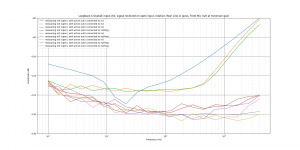
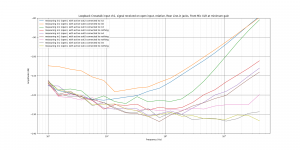
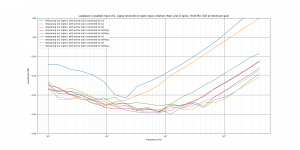
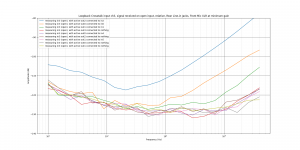
So, if low input crosstalk is necessary, this soundcard really has three inputs: two on the back, and one of the line jacks on the front. That's useful to know, which is why I did this test.
But, well, below 10kHz, the rest of the inputs aren't that bad.
Distortion
All the line outputs are identical. The inputs, however, are not.
Rear line inputs and outputs are powered by timeless audiophile standard NE5532, so they deliver a pretty honest performance in loopback.
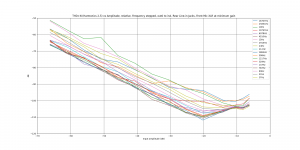
Front XLR mic inputs however, contain a JRC knockoff of the TL072, and it shows.
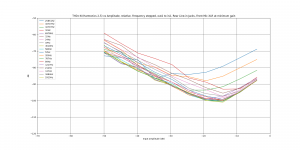
And the two front jack line inputs run on the same circuit, including the accursed 072.
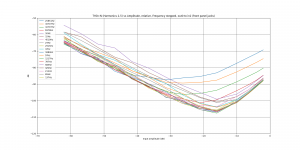
I'm not exactly sure of the amplitude calibration in these graphs, but well, the take-home point is, if you want to measure distortion, it is wise to stay away from the inputs that have a TL072 in the signal path. The rise in THD at high frequency is truly spectacular.
All the line outputs are identical. The inputs, however, are not.
Rear line inputs and outputs are powered by timeless audiophile standard NE5532, so they deliver a pretty honest performance in loopback.

Front XLR mic inputs however, contain a JRC knockoff of the TL072, and it shows.

And the two front jack line inputs run on the same circuit, including the accursed 072.

I'm not exactly sure of the amplitude calibration in these graphs, but well, the take-home point is, if you want to measure distortion, it is wise to stay away from the inputs that have a TL072 in the signal path. The rise in THD at high frequency is truly spectacular.
Noise modulation
Now of course the next thing to measure on a sigma delta DAC is how it modulates the noise according to signal amplitude.
DAC output plays a 0.5 Hz sine wave, which goes into a RC highpass filter to get rid of the signal as much as possible, which is then fed into one of the mic inputs. This is the curve on top. It looks a bit wonky at the beginning, I think I screwed-up the ramp-up in software, but that doesn't matter. Amplitude is very low, due to the output coupling cap and the RC filter removing most of the 0.5Hz signal.
The mic preamps have pretty low noise, so they should mostly let us see the noise from the DAC (middle trace).
Then, the signal is filtered in software to keep only the noise, and its RMS amplitude extracted and smoothed (bottom trace). This does not give the absolute value of the noise power/amplitude, but how it varies.

So, this DAC (and associated output circuitry) has 35% more noise at full scale than at zero output. Noise is quite proportional to signal absolute value, and it doesn't seem to be doing anything funny. Using a higher cutoff frequency on the noise amplitude detector doesn't reveal any gremlins either.
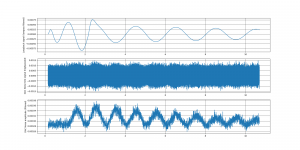
Now of course the next thing to measure on a sigma delta DAC is how it modulates the noise according to signal amplitude.
DAC output plays a 0.5 Hz sine wave, which goes into a RC highpass filter to get rid of the signal as much as possible, which is then fed into one of the mic inputs. This is the curve on top. It looks a bit wonky at the beginning, I think I screwed-up the ramp-up in software, but that doesn't matter. Amplitude is very low, due to the output coupling cap and the RC filter removing most of the 0.5Hz signal.
The mic preamps have pretty low noise, so they should mostly let us see the noise from the DAC (middle trace).
Then, the signal is filtered in software to keep only the noise, and its RMS amplitude extracted and smoothed (bottom trace). This does not give the absolute value of the noise power/amplitude, but how it varies.

So, this DAC (and associated output circuitry) has 35% more noise at full scale than at zero output. Noise is quite proportional to signal absolute value, and it doesn't seem to be doing anything funny. Using a higher cutoff frequency on the noise amplitude detector doesn't reveal any gremlins either.

UR44C Output Impedance
Thanks for your detailed assessment of the UR44C. Don't know if its possible but I was wondering if you knew what the output impedance of the headphone amp of the UR44C was.
When watching the review by Julian Krause on interface comparisons, Interface Headphone Amp Comparison (Focusrite, Behringer, Audient, Motu, SSL, NI, and Steinberg) - YouTube, he mentions the UR22C has 91 Ohms which is high compared to other audio interfaces.
When reading the tech specs of the manuals for both the UR22C and UR44C, the headphone info is different.
UR22C
Steinberg Ur22c phones info - Album on Imgur
UR44C
Steinberg UR44C phones info - Album on Imgur
Was thinking the output impedenace of the UR44C would be lower than the UR22C given its higher max output level
Headphone amp
It makes my Sennheiser HD6XX sound like they're worth $10, so, not optimum.
Thanks for your detailed assessment of the UR44C. Don't know if its possible but I was wondering if you knew what the output impedance of the headphone amp of the UR44C was.
When watching the review by Julian Krause on interface comparisons, Interface Headphone Amp Comparison (Focusrite, Behringer, Audient, Motu, SSL, NI, and Steinberg) - YouTube, he mentions the UR22C has 91 Ohms which is high compared to other audio interfaces.
When reading the tech specs of the manuals for both the UR22C and UR44C, the headphone info is different.
UR22C
Steinberg Ur22c phones info - Album on Imgur
UR44C
Steinberg UR44C phones info - Album on Imgur
Was thinking the output impedenace of the UR44C would be lower than the UR22C given its higher max output level
...this DAC (and associated output circuitry) has 35% more noise at full scale than at zero output.
Its interesting to compare the sound of a dac like the one above with a dac that doesn't have anything like that much noise modulation. What that tends to sound like to me is interesting. It doesn't sound like noise, per se. It sounds like information is missing. Kind of like having a video monitor that doesn't go to black between icons on a black desktop. Some monitors will only go down to light grey. It means low video level colors could be masked by the gray color that dominates at low levels. However, that video analogy isn't entirely like noise modulation of audio. Modulated noise fools you into thinking the noise level is very low, and thinking that no low level information is missing. Its only by listening to the same audio without noise modulation that it becomes apparent a lot of low level information was being hidden/masked. Doesn't take a dac to do that either. An amplifier with high loop gain can produce the same symptom of subtly masked low level information. Its one reason some people rave about zero-global-feedback amplifiers. Measured distortion is higher, but noise modulation may be less.
Honestly, you would think the only problem with digital audio today is 'Noise modulation'. Every second thread topic begins with a reply from you nattering on about 'noise modulation'. Are you trying to get the number of hits on that search term up personally?
Mr. Gadget, I have two SOA measuring Neurochrome headphone amps, and a Benchmark AHB2. All measure very low distortion and noise. Yet they sit unused. Why? Something is wrong, something is being missed. There is some reason people have been complaining about global feedback for a long time. Its not just their imagination. We need to figure out what it is, measure it, and reduce its effects just like we have done with distortion. To me, to my ears, it just could be a noise modulation effect. That's my opinion.
- Home
- Source & Line
- Digital Line Level
- Steinberg UR44C: Review
